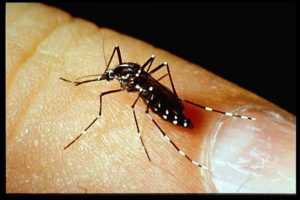Farm & Ranch
[AgriLife Today] Tackling mosquito, tick problems in Texas

By: Blair Fannin
Experts convene as part of Western Gulf Center of Excellence for Vector-Borne Diseases
Writer: Blair Fannin, 979-845-2259, [email protected]
Contact: Dr. David Ragsdale, 979-845-2510, [email protected]
WESLACO – With ticks posing an ongoing threat to Texas’ cattle industry and mosquitoes causing challenging human health diseases such as Zika virus, a consortium of public health experts met at the Texas A&M AgriLife Research and Extension Center in Weslaco to hear the latest research and offer potential solutions.
 Texas A&M AgriLife Research and the University of Texas Medical Branch at Galveston are leading a collaboration to solve threats from the pests as members of the Western Gulf Center of Excellence for Vector-Borne Diseases.
Texas A&M AgriLife Research and the University of Texas Medical Branch at Galveston are leading a collaboration to solve threats from the pests as members of the Western Gulf Center of Excellence for Vector-Borne Diseases.
The consortium has received $10 million from the Centers for Disease Control and Prevention over five years to carry out applied research and implement communities of practice across Texas to better respond to mosquito and tick-borne diseases, according to organizers.
“The Center of Excellence shows the true value of partnerships in confronting significant public health issues such as Zika and West Nile virus,” said Dr. Craig Nessler, AgriLife Research director in College Station. “The center combines the strengths of cutting edge research with public health surveillance and control, along with Extension education programs on how to lower mosquito numbers. Talented individuals from each of these areas form a strong team working together with the common goal of reducing disease.”
 “The goal of this meeting was to gather the scientists and the public health officials in South Texas where we all could report progress on the research projects,” said Dr. David Ragsdale, head of the department of entomology at Texas A&M University in College Station.
“The goal of this meeting was to gather the scientists and the public health officials in South Texas where we all could report progress on the research projects,” said Dr. David Ragsdale, head of the department of entomology at Texas A&M University in College Station.
“It also was where we could exchange information to inform the center members where there may be areas we can help either with our expertise or where further research is needed,” Ragsdale said.
The funding is being used to:
– Support applied research to create new methods of vector and disease control.
– Translate scientific advances into real-world tools to benefit the public.
– Facilitate communication and collaboration between academic institutions, public health agencies, federal institutions and communities, vital for controlling vector-borne diseases.
– Create an ongoing feedback loop between community needs and translational research results.
– Train the next generation of leaders in public health entomology.
Attending the meeting were health officials representing the cities of Laredo, McAllen, Harlingen, Brownsville and Corpus Christi and Hildalgo, Cameron and Nueces counties, as well medical entomologists and vector control specialists from the Texas Department of State Health Services, and AgriLife Research scientists.
Other key partners in Valley research activities include faculty at the AgriLife center at Weslaco and University of Texas Rio Grande Valley.
Ragsdale said just over the last week the CDC’s Vital Signs website released information on how vectored diseases are on the rise throughout the country. These include tick-borne diseases in the northeast and outbreaks of Zika and other mosquito-borne viruses in Florida, Puerto Rico and Texas.
For more information, go to https://www.cdc.gov/vitalsigns/vector-borne/index.html.
“Our Western Gulf Center of Excellence in Vector-Borne Diseases is one of five such centers in the U.S. tasked with solving some of these problems,” Ragsdale said. “While ticks and human disease are a lower priority in Texas because there are just a handful of cases each year, ticks and tick-borne cattle diseases are a major concern.”
-30-
Find more stories, photos, videos and audio at http://today.agrilife.org
Farm & Ranch
Acorn Toxicity

By Barry Whitworth, DVM, MPH
With the prolonged drought, most pastures in Oklahoma end up in poor condition. With the lack of available forage, animals may go in search of alternative foods.
If oak trees are in the pastures, acorns may be a favorite meal for some livestock in the fall. This may result in oak poisoning.
Oak leaves, twigs, buds, and acorns may be toxic to some animals when consumed.
To read more, pick up a copy of the November edition of North Texas Farm & Ranch magazine, available digitally and in print. To subscribe by mail, call 940-872-5922.

Farm & Ranch
Silver Bluestems

By: Tony Dean
There are a handful of grasses on North Texas grazing lands ranchers need to know, not because they are highly desirable, but rather because they are not of much value. I call them “decom” plants, which is am acronym for “Don’t Ever Count On Me.” Silver bluestem is a “decom” grass.
Silver bluestem is a perennial which grows in all areas of Texas. It can survive in almost all soil types, and in full sun conditions or in semi shade. It grows up to three feet tall and is easily recognized with the presence of the white fuzzy seed head. Also, one of the identifying characteristics of Silver bluestem is a bend in the stems at each node, causing the plants to take on a rounded shape as they mature.
To read more, pick up a copy of the November edition of North Texas Farm & Ranch magazine, available digitally and in print. To subscribe by mail, call 940-872-5922.

Farm & Ranch
Meanwhile Back At The Ranch

By: Rayford Pullen
Fall is here which means winter is closing in on us and before we officially get into winter, we need to make sure our factories are either producing or will be producing in a few months.
We have been pregnancy testing our cows this fall and if they are not bred or nursing a calf, we are bidding them adios. With annual costs somewhere between $900.00 and $1,000.00 per cow, those cows not producing a live weaned calf are costing us quite a bit.
To read more, pick up a copy of the November edition of North Texas Farm & Ranch magazine, available digitally and in print. To subscribe by mail, call 940-872-5922.
-

 Country Lifestyles2 years ago
Country Lifestyles2 years agoScott & Stacey Schumacher: A Growth Mindset
-

 Country Lifestyles8 years ago
Country Lifestyles8 years agoStyle Your Profile – What your style cowboy hat says about you and new trends in 2017
-

 HOME8 years ago
HOME8 years agoGrazing North Texas – Wilman Lovegrass
-

 Equine1 year ago
Equine1 year agoThe Will to Win
-

 Country Lifestyles5 years ago
Country Lifestyles5 years agoAmber Crawford, Breakaway Roper
-

 Outdoor9 years ago
Outdoor9 years agoButtercup or Primrose?
-

 Country Lifestyles8 years ago
Country Lifestyles8 years agoJune 2016 Profile – The man behind the mic: Bob Tallman
-

 Country Lifestyles8 years ago
Country Lifestyles8 years agoDecember 2016 Profile, Rusty Riddle – The Riddle Way




